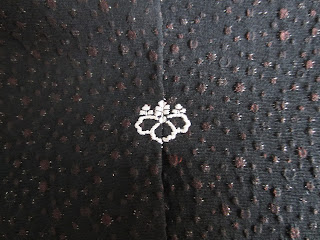Spinning Yarns and Weaving Stories
I have been decluttering my weaving 'stuff' to dispose of old material and records that I no longer require. I came across details of an exhibition that the Durham Guild held in 2004. I still use one of the items I made. Here is the description of the exhibition from the catalogue we produced.
'To celebrate our 25th anniversary in 2004 , the Durham Guild of Spinners, Weavers and Dyers decided to hold an exhibition at the Oriental Museum. Our work was to be inspired by the collection at the Museum. The question arose as to the title. What to call our exhibition? For an earlier display of work at the Botanic Garden two Guild members had produced wall hangings: Jen Campbell made a vibrantly coloured house and Elsie Shaw produced a subtle and sensitive tapestry of a tree. Independently, they told me the story behind the image that they had chosen. The stories were interesting, informative and also personal and certainly added to an appreciation of the pieces of work. So, our design challenge was born - ‘Spinning Yarns and Weaving Stories’.'
The stories gave the visitor to our exhibition an insight into the inspiration and creative journey that led to the item on display. Guild members wrote their ‘stories’ of how they were inspired by an exhibit(s) in the Museum and how it led to the design of their hand-made item. These stories appeared next to each person’s work.
Here is the cover of the exhibition booklet.
My work for the exhibition was inspired by Japanese kites and Japanese shop curtains which were exhibited in the museum.
Japanese Kites.
The Oriental Museum has a fascinating collection of traditional Japanese kites. They were mounted high up on a wall but have no strings or tails. Using a variety of traditional shapes, they feature characters from Japanese history and folklore. They are now in storage.
Three Kites.
1. The Sanjo kite shows Minamoto no Yoshitsune a 12th century samurai. It was made by Hikoichi, Kobayashi Creation date 1900-1950; Meiji Period; Taisho; Showa Period. The museum catalogue has this description: kite featuring Minamoto no Yoshitsune, a 12th century character. He is wearing a red, yellow and blue helmet. White face with pink shading in eye and cheek area. Caption in top right hand corner.
https://palimpsest.dur.ac.uk/adlib/?action=image&image=oriental%2F1986%2F1986.50.jpg
2. The Sagara kite is a painting of Matsuomani from the play Sugawara Denju Tenarai Kagami in the Bunraku theatre. Creation date: 1900-1950; Meiji Period; Taisho; Showa Period. Description: Banraku kite made by Mitsuro Otatuke,
https://palimpsest.dur.ac.uk/adlib/?action=image&image=oriental%2F1986%2F1986.47.jpg
3. Chozaburo Kitamura, kite, featuring Ryuotaro. The face is white with red upper lip and red patches around eye and cheek bone. Blue sword placed between teeth. Lots of black hair. Colourful background. Here is the link to the original. https://palimpsest.dur.ac.uk/adlib/?action=image&image=oriental%2F1986%2F1986.49.jpg
I liked this particular kite and drew a copy. I photographed the one hanging in the museum and I transferred my copy onto a tee shirt which I still have after all theses years.
Here is my tee shirt.
I remembered the triangular kites from my childhood and my homemade kite tails - simple lengths of string with coloured paper tied in bows. I decided to use the kites as my inspiration and the idea of kite tails to design and weave some scarves. I thought of words to describe kite tails - light, airy, frilly, floating, fluttering, balanced. My scarves had to have some of these properties but also to be practical as scarves.
 |
| Floating clouds |
Japanese shop curtains: Noren
 |
| Tsuru a crane |
 |
| My display of curtains and scarves. |








